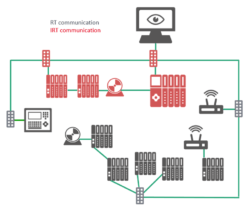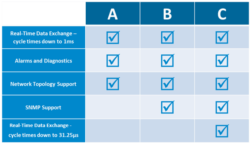PROFINET employs its first two communication channels: TCP/IP and UDP/IP, and Real-Time (RT) for most data exchange. It employs TCP/IP (or UDP/IP) communications for non-time-critical tasks, such as configuration, diagnostics, and parameterization. And PROFINET RT handles time-critical data exchange. Yet, some industrial applications require faster performance. For those applications, PROFINET employs the Isochronous Real-Time (IRT) channel.
What is PROFINET IRT?
PROFINET IRT eliminates variable data delays by enhancing the rules employed to switch Ethernet traffic, and by creating special rules for PROFINET traffic. It fulfills all synchronization requirements and allows deterministic communication. Specifically, PROFINET IRT enables applications having a jitter of less than 1 microsecond.
Mechanisms
Synchronization: For the bus cycles to run synchronously with a maximum deviation of 1 µs, all devices involved in the synchronous communication must have a common clock. A clock master uses synchronization frames to synchronize all local clock pulse generators of devices within a clock system (IRT domain) to the same clock.
Bandwidth Reservation: The cyclic data packets are transferred as synchronized packets on a reserved bandwidth. All other packets, such as packets for diagnostics or TCP/IP, share the rest of the Ethernet bandwidth. The reserved bandwidth protects time-sensitive data from delays caused by other data. Also, it allows for a high level of determinism.
Scheduling: To be able to communicate in real-time, the controller creates a schedule for IRT communication. The schedule is like a time table that indicates precisely when each frame must be sent out. Then, the IRT frames arrive at the receiver in a deterministic fashion.
PROFINET IRT Performance
By default, with PROFINET IRT, the minimum update rate is 250 µs. But, it can be reduced to as low as 31.25 µs with the appropriate hardware. To expand data volumes when cycle times are set at less than 250 µs, PROFINET IRT employs additional mechanisms, such as:
Fast-forwarding: Every Ethernet frame has an ID built-in. The ID tells a node if the packet is intended for it or another device on the network. By moving the ID to the beginning of the frame, the device can decipher sooner, whether it should process the data containing the packet or simply forward the frame.
Dynamic Packing: Instead of sending individual frames for each node, a summation frame is used. It contains all data for devices in a line. Once a device processes part of the frame, the processed data stays in the respective device, minimizing the remaining packet’s size.
Fragmentation: Standard TCP/IP traffic can coexist on the same wire as PROFINET traffic. With fragmentation, large TCP/IP frames split up into smaller frames. Then, more PROFINET data can be transmitted.
Implementation
PROFINET components that provide IRT capabilities are part of Conformance Class C. If you are unfamiliar with the conformance classes, you can read this article: PROFINET Conformance Classes. To implement PROFINET IRT, controllers and devices that require IRT performance, and every Ethernet Switch in between those components must be certified according to PROFINET’s Conformance Class C.
The user must then configure the IRT synchronization domain; they must specify the cycle times for the devices. Then, the controller calculates the amount of bandwidth needed for the IRT operation. Finally, the network topology must be defined in the controller to optimize the IRT transmission schedule within the IRT time bands. The whole process is only slightly more involved than setting up the rest of the network.
PROFINET IRT FREQUENTLY ASKED QUESTIONS
What cycle time can I achieve with PROFINET IRT?
The minimum update rate for PROFINET IRT is 250 µs. With the appropriate hardware, you can achieve cycle times of 31.25 µs with 1 µs of jitter.
Do I need specialized hardware for PROFINET IRT?
You will need IRT capable PROFINET components. First, when designing your network, you should determine which components require IRT performance. Most likely, the majority of components will only require PROFINET RT. Still, some drives or motion control applications might require IRT performance. The devices and controllers involved in such communication and all nodes in between those controllers and devices require IRT capabilities. For example, the diagram on the right illustrates this concept. In the picture, one controller and a couple of IO devices require IRT capabilities. Since those nodes are connected in a ring configuration, all nodes in the ring must be IRT capable (highlighted in red). The remaining devices in the network, do not need to be IRT capable.
And what about cables and connectors? There is no need for specialized cables or connectors in a PROFINET network. Even if you are using IRT, the communication medium is standard Ethernet. Therefore, you can employ standard Ethernet cables and connectors.
What PROFINET devices support PROFINET IRT?
Only Conformance Class C devices support PROFINET IRT.
PROFINET products have a defined set of features that are mandatory based on its conformance class. There are three PROFINET conformance classes: A, B, and C. Conformance Class A (CC-A) is the most basic, while C (CC-C) is the most advanced. Specifically, CC-C provides IRT functionality.
I use PROFIsafe in a PROFINET network. Can I employ PROFINET IRT for safety messages?
Yes, you can utilize PROFINET IRT to exchange PROFIsafe messages. The end-user decides which is the most suitable communication channel for each particular application. You can opt for the IRT communication channel, as long as your hardware supports this capability.
What type of switch do IRT devices employ? Cut-through or store and forward?
Conformance Class C, PROFINET IRT devices, have a cut-through switch built into the hardware to help avoid delays and minimize jitter for motion control applications.
For more information on the PROFINET communication channels, download this White Paper:
-Nelly Ayllon
For more information about how to implement PROFINET IRT, download this White Paper:
PROFINET IRT: The Solution for Synchronous Real-time Applications


